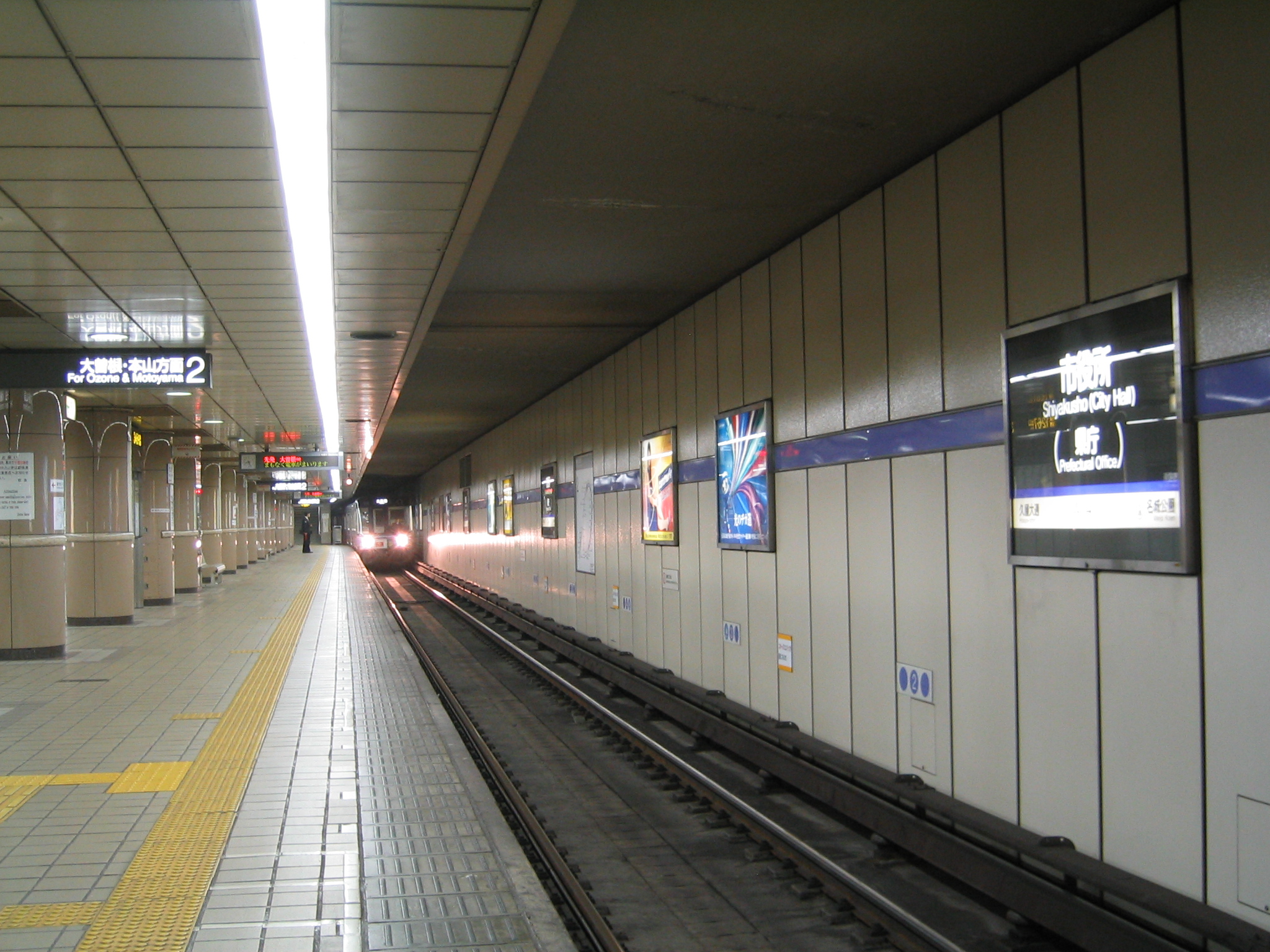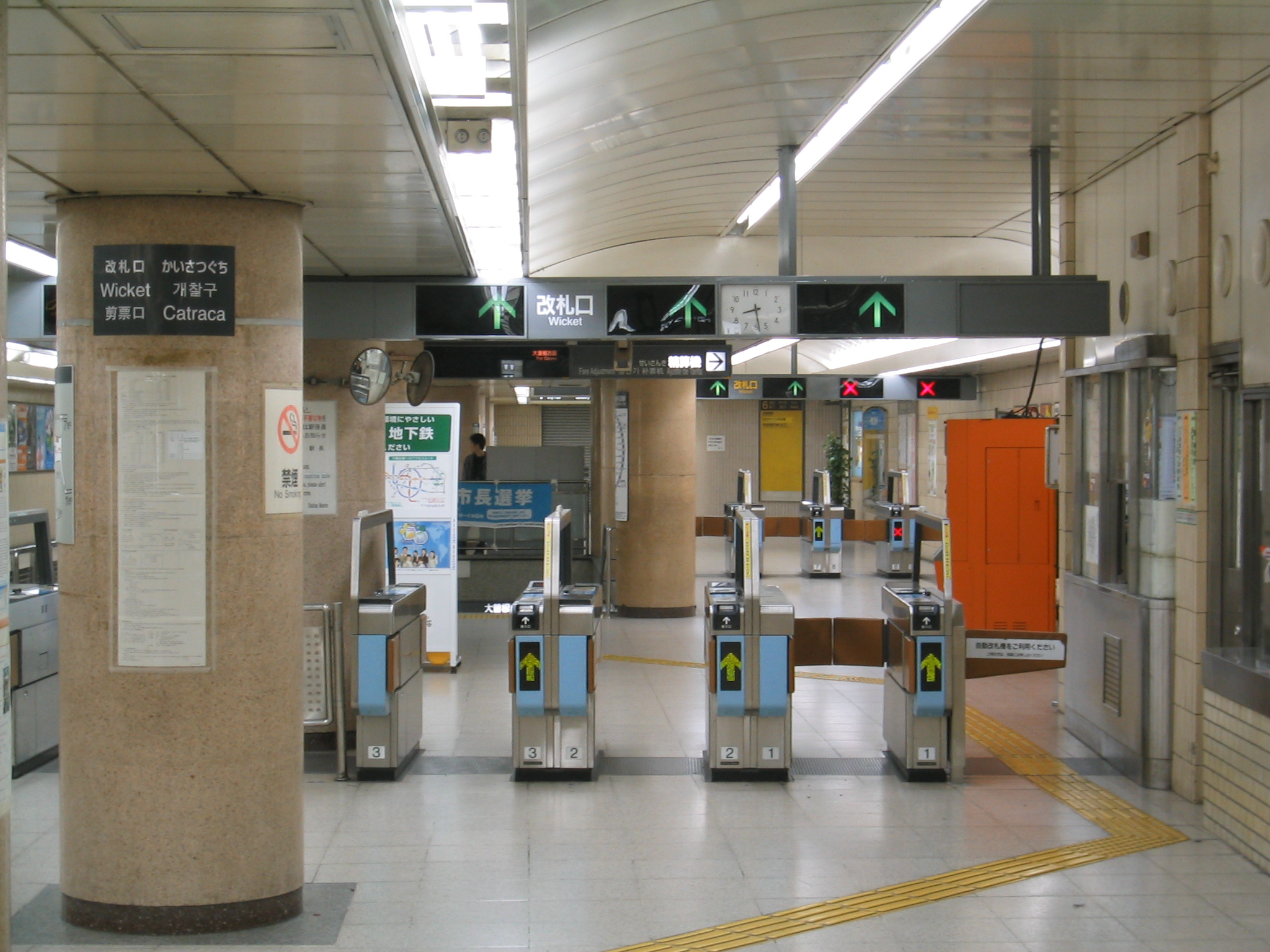Nagoya Subway on:
[Wikipedia]
[Google]
[Amazon]
The is a




Transportation Bureau, City of Nagoya – official website
{{Authority control
rapid transit
Rapid transit or mass rapid transit (MRT), also known as heavy rail or metro, is a type of high-capacity public transport generally found in urban areas. A rapid transit system that primarily or traditionally runs below the surface may be ...
system serving Nagoya
is the largest city in the Chūbu region, the fourth-most populous city and third most populous urban area in Japan, with a population of 2.3million in 2020. Located on the Pacific coast in central Honshu, it is the capital and the most po ...
, the capital of Aichi Prefecture
is a prefecture of Japan located in the Chūbu region of Honshū. Aichi Prefecture has a population of 7,552,873 () and a geographic area of with a population density of . Aichi Prefecture borders Mie Prefecture to the west, Gifu Prefecture ...
in Japan. It consists of six lines that cover of route and serve 87 stations. Approximately 90% of the subway's total track length is underground.
The subway system is owned and operated by Transportation Bureau City of Nagoya
is a municipal government agency responsible for public transport in Nagoya, Japan. The organization operates subways and buses. It was founded in 1922, as an operator of Nagoya City Tram bought from Nagoya Electric Railroad, the current Nago ...
and, like other large Japanese cities including Tokyo
Tokyo (; ja, 東京, , ), officially the Tokyo Metropolis ( ja, 東京都, label=none, ), is the capital and largest city of Japan. Formerly known as Edo, its metropolitan area () is the most populous in the world, with an estimated 37.46 ...
and Osaka
is a designated city in the Kansai region of Honshu in Japan. It is the capital of and most populous city in Osaka Prefecture, and the third most populous city in Japan, following Special wards of Tokyo and Yokohama. With a population of ...
, is heavily complemented by suburban rail
Commuter rail, or suburban rail, is a passenger rail transport service that primarily operates within a metropolitan area, connecting commuters to a central city from adjacent suburbs or commuter towns. Generally commuter rail systems are co ...
, together forming an extensive network of 47 lines in and around Greater Nagoya. Of them, the subway lines represent 38% of Greater Nagoya's total rail ridership of 3 million passengers a day.
In 2002, the system introduced Hatchii
is a fictional character which serves as the mascot for Nagoya Municipal Subway.
Inspiration
Nagoya Municipal Subway adopted the character named Hatchii to commemorate their 80th year of operation on . The character has a human form wearing ...
as its official mascot.
__TOC__
Lines and infrastructure
The six lines that comprise the Nagoya subway network are, for the most part, independent. However, Meikō Line services partially interline with the Meijō Line, and the operations of both lines are combined. Therefore, there are in fact five distinct services on the subway. They are mostly self-contained, but two of its lines have through services onto lines owned and operated by Meitetsu, the largestprivate railway
A private railway is a railroad run by a private business entity (usually a corporation but not need be), as opposed to a railroad run by a public sector.
Japan
In Japan, , commonly simply ''private railway'', refers to a public transit railway o ...
operator in the region. One of these, the Kamiida Line, is essentially an extension of the Meitetsu Komaki Line to which it connects.
The first two subway lines, the Higashiyama and Meijō/Meikō Lines, run on standard gauge track and use 600 volt DC electrification from a third rail. They are three of the eleven subway lines in Japan which use both third-rail electrification and standard gauge track (the Ginza and Marunouchi lines in Tokyo
Tokyo (; ja, 東京, , ), officially the Tokyo Metropolis ( ja, 東京都, label=none, ), is the capital and largest city of Japan. Formerly known as Edo, its metropolitan area () is the most populous in the world, with an estimated 37.46 ...
are the only other two lines to use third rail at that voltage; five of the eight lines of the Osaka Metro and the Blue Line in Yokohama
is the second-largest city in Japan by population and the most populous municipality of Japan. It is the capital city and the most populous city in Kanagawa Prefecture, with a 2020 population of 3.8 million. It lies on Tokyo Bay, south of T ...
all use 750 V DC third rail). Subsequent lines were built to narrow gauge and employ 1,500 volt DC electrification from overhead line
An overhead line or overhead wire is an electrical cable that is used to transmit electrical energy to electric locomotives, trolleybuses or trams. It is known variously as:
* Overhead catenary
* Overhead contact system (OCS)
* Overhead equipm ...
s, in common with most other rapid transit lines in the country.
As with other railway lines in Japan, tickets can be purchased from ticket vending machines in stations. Since February 2011, this has largely been supplemented by Manaca, a rechargeable smart card. By the next year, it had replaced Tranpass, the predecessor integrated ticketing system, which could be used at all subway stations and for other connected transportation systems in the region.
Notes


Connecting services
JR Central
*Tōkaidō Shinkansen
The is a Japanese high-speed rail line that is part of the nationwide Shinkansen network. Along with the Sanyo Shinkansen, it forms a continuous high-speed railway through the Taiheiyō Belt, also known as the Tokaido corridor. Opened in 19 ...
: at Nagoya
is the largest city in the Chūbu region, the fourth-most populous city and third most populous urban area in Japan, with a population of 2.3million in 2020. Located on the Pacific coast in central Honshu, it is the capital and the most po ...
:(for Shin-Yokohama, Tokyo, Kyoto, and Shin-Osaka)
*Tōkaidō Main Line
The is a major Japanese railway line of the Japan Railways Group (JR Group) network, connecting and stations. It is long, not counting its many freight feeder lines around the major cities. The high-speed Tōkaidō Shinkansen largely parallel ...
: at Nagoya and Kanayama
:(for Gifu, Ōgaki, Obu, Kariya, Okazaki, Toyohashi, and Hamamatsu)
* Chūō Main Line: at Nagoya, Kanayama, Tsurumai, Chikusa, and Ōzone
:(for Kozoji (transfer to former Expo Site), Tajimi, and Nakatsugawa)
* Kansai Main Line: at Nagoya and Hatta
:(for Yokkaichi, Tsu and Kameyama)
* Takayama Main Line: at Nagoya
:(Limited Express only, for Gero and Takayama)
Meitetsu
*Meitetsu Nagoya Line
{{BS-map
, title=Nagoya Main Line
, title-bg=red
, top=
*Subway: Nagoya Municipal Subway
*Lines are Meitetsu unless otherwise noted
, collapse=yes
, map=
{{BS, STR, , , Tokaido Main Line}
{{BS3, , STR, hSTR, , , Tokaido Shinkansen}
{{BS5, ...
: at Nagoya and Kanayama
:(for Meitetsu Gifu, Chiryu, Hekinan, Nishio, Higashi Okazaki, Toyohashi, and Toyokawa Inari)
*Meitetsu Tokoname Line
The is a railway line in Aichi Prefecture, Japan, operated by the private railway operator Nagoya Railroad (Meitetsu), connecting Jingū-mae Station in Nagoya and Tokoname Station in Tokoname.
Stations
L:
S:
E:
R:
L:
MU:
All ...
: at Nagoya and Kanayama
:(for Otagawa, Chita Handa, Kowa, Utsumi, Tokoname, and Central Japan Int'l Airport)
*Meitetsu Inuyama Line
The is a 26.8 km Japanese railway line operated by the private railway operator Nagoya Railroad (Meitetsu), which connects Biwajima Junction in Kiyosu, Aichi with Shin-Unuma Station in Kakamigahara, Gifu. Together with the Kakamigahara ...
: at Nagoya, Kanayama, and Kami-Otai
:(for Iwakura, Inuyama, Mikakino and Shin Kani)
* Meitetsu Tsushima Line: at Nagoya and Kanayama
:(for Tsushima, Saya and Yatomi)
* Meitetsu Seto Line: at Sakae and Ōzone
:(for Owari Seto)
*Meitetsu Toyota Line
The is a railway line in Aichi Prefecture, Japan, operated by the private railway operator Nagoya Railroad (Meitetsu) connecting Umetsubo Station in Toyota with Akaike Station in Nisshin. The line operates a through-service onto the Nagoya ...
: at Akaike
:(for Toyotashi)
Kintetsu
* Kintetsu Nagoya Line: at Nagoya and Hatta :(for Yokkaichi, Tsu, Nakagawa, Matsusaka, Ise, Toba, and Osaka)Nagoya Seaside Rapid Railway
*Aonami Line
The is a third-sector railway line in the city of Nagoya operated by the . Officially called the , it connects Nagoya Station with Kinjō-futō Station, and was a freight branch line of Tokaido Main Line, converted for passenger usage in Octo ...
: at Nagoya
:(for Kinjo-Futo (Nagoya International Exhibition Hall))
Network Map
See also
* List of metro systemsReferences
External links
Transportation Bureau, City of Nagoya – official website
{{Authority control